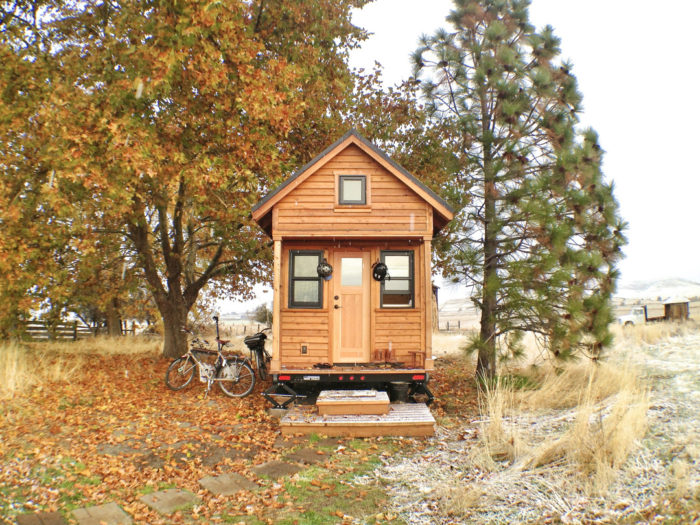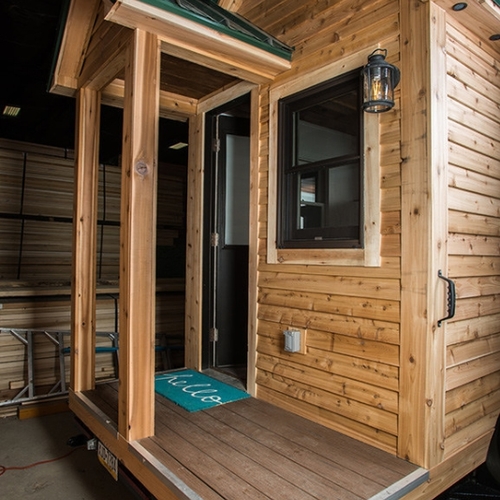
Image Credit: Tammy Strobel / CC BY 2.0 / Flickr
Pima County, Arizona, has eased rules on houses of less than 400 square feet, making them legal anywhere that’s zoned for single-family dwellings as long as they sit on permanent foundations.
According to a post at Construction Dive,Pima County has also relaxed some building code minimums that aren’t deemed necessary for really small buildings, including minimum dimensions for rooms, ceilings, and windows. Ladders can replace stairways to lofts, and loft areas may have “reduced fall protection.”
In other respects, tiny houses still have to comply with the Pima County building code, according to a summary of the regulations posted online. Pima County includes the city of Tucson.
Putting buildings on trailers had been a way of getting around stringent zoning requirements in the past, but they’re now covered by more restrictive zoning regulations and permitted only in specific zones. The new rules also make a distinction between tiny houses built on a chassis with its suspension and axle components removed and those that are build on a mobile chassis.
More communities are popping up
Advocates of tiny houses point to simpler lifestyles with fewer possessions and lower mortgage costs as major advantages of living in houses far smaller than the norm. Zoning and building regulations are often a sticking point, but Construction Dive says that the changes in Pima County and elsewhere are a sign that objections are beginning to wane.
Washington, D.C., last month changed its accessory dwelling regulations in some neighborhoods, allowing homeowners to build small buildings on their lots and either rent them or allow family members or employees to live in them. The changes, which go into effect in September, include some restrictions but will help to ease a housing shortage as well as benefit homeowners, according to advocates.
Tiny house communities are beginning to appear around the country, but whether the boomlet constitutes a “trend” depends on who you talk to. Some, like Professional Builder editor Amy Albert, think the growing appeal of tiny houses could have major implications for housing, an earlier Construction Dive report said, while major builders have largely stayed away.
“Fundamentally, ground-oriented housing is not efficient, and proportionately, too much of the cost is chewed up by high land cost,” Mattamy Homes COO Brian Johnston told Construction Dive. “The answer is going up in the air, not trying to cut construction costs by building smaller homes.”
Communities of tiny houses have appeared in Washington, D.C., Washington state, Colorado, and Texas. Building materials supplier 84 Lumber has started offering tiny house kits, and a few architectural firms are working on floor plans for tiny houses on the hunch they will continue to become more appealing.
There is also continued resistance. In Tallahassee, Florida, for example, people who would be living near a proposed development of affordable tiny houses have gone to court in an effort to block the $7.8 million project, The Tallahassee Democrat reported. “The Dwellings” would include homes ranging in size from 250 to 400 square feet.
“I was devastated when I heard this news,” said a potential neighbor who bought a house near the proposed development eight months ago. “It’s like an omission of the truth. An omission, in my opinion, is deceitful.”
Weekly Newsletter
Get building science and energy efficiency advice, plus special offers, in your inbox.















7 Comments
Why the prejudice against tiny homes?
Who objects to tiny or small homes and why? I see this prejudice in my area also. Nearly all the building properties are in subdivisions whose CC&Rs restrict minimum home sizes to 1000, 1500, even 2500 sq ft. A high-quality small home would just ruin the neighborhood? Older couples are looking to downsize and younger couples can't afford big, but that's what you must build to live here.
Jay
I agree with you entirely. However two things have muddied the waters a bit:
The inclusion of small homes as secondary dwellings on urban lots can change neighbourhoods significantly - I think often for the better - but I can see how people might see this as altering their neighbourhoods.
The small home movement is often identified with houses on wheels (like the one in the photo), which are a completely different animal, with all sorts of attendant problems.
Those things aside, why the fuss? We are really just talking about returning to what was the average North American house size until somewhere in the 60s.
Building codes and tiny houses
Jay,
Going back a hundred years, building code requirements that specified minimum sizes for bedrooms and homes arose out of progressive social movements trying to address urban poverty. These codes were a response to overcrowded tenements. The hope was to prevent slumlords from building new tenement buildings and cramming as many poor people into the tenements as they could.
Unsurprisingly, these codes are now used in some areas of the country to exclude low-income people and to prevent innovations in living arrangements. I think that more flexible building codes that allow tiny houses are a good idea. Let's see what happens after these codes are changed.
In the area I live in
In the area I live in property taxes fund a lot of government services. I tiny house won't supply the taxes to the local government that a McMansion will.
It is similar to what is happening as a result of hybrid cars and electric cars where the reduction in gas taxes from fuel efficient cars no longer provide the taxes to fund the roads. Now the government has to look into taxing cars by miles driven not on how much fuel is used.
I think part of the appeal of the tiny houses is the lower property taxes owed. In reality property taxes over the life time of owning a home can exceed the actual construction costs of a home. In the area I live in it isn't uncommon for the property taxes to be higher than ones mortgage and eventually you will pay the mortgage off while property taxes increase forever.
A lot of current regulations increase the costs of housing that in turn means the higher priced homes bringing in more funds to the government that write the regulations in the first place.
Houses on wheels are taxed at an even lower rate.
why the prejudice?
@Jay - It's pretty simple. In most established communities and neighborhoods, these tiny homes will lower surrounding property values. In rural locations, they probably will not have that affect. The zoning stipulations are there for the reasons Mr. Holladay alludes to - AS WELL AS protecting exciting property values. For instance, the zoning protects you from having your next door neighbor erect a 50' billboard, or subdividing their property into many smaller lots for trailers and tiny homes (which apart from aesthetics, there is little difference).
While I find the tiny homes to be a novel housing option, they really do not suffice for affordable housing as land costs contribute greatly to one's home value. Hence, (one of) the only place they can be built legally in in faraway, rural locations - which is distant from schools, public transportation, parks and other walk-able amenities an income challenged family or individual might be needing.
As an architect i see the tiny home movement as one of two extremes - the other being the Mc Mansion. It is my hope that a healthy middle can be o sought after, i.e the Not-so-big house movement.
Wow, these comments are old! It almost doesnt make sense to reply! So for anyone reading this in 2019, I disagree with Edward. Tiny houses on wheels are built much better than trailers. THOWs are built with 2x4s and other regular construction materials while trailers are built with plywood, thin sheet metal, veneers and plastics. Trailers are flimsy while THOWs are solid. THOWs look like regular houses and trailers dont.
Denro55,
That my be true - although I'm not sure it makes any significant difference. Let's say they are much better built, and look better. They still share all the attributes of trailers, and we haven't had a lot of luck creating viable communities or neighbourhoods of mobile homes.
Log in or create an account to post a comment.
Sign up Log in